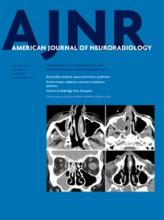Research ArticleAdult Brain
Open Access
Longitudinal Mixed-Effect Model Analysis of the Association between Global and Tissue-Specific Brain Atrophy and Lesion Accumulation in Patients with Clinically Isolated Syndrome
M. Varosanec, T. Uher, D. Horakova, J. Hagemeier, N. Bergsland, M. Tyblova, Z. Seidl, M. Vaneckova, J. Krasensky, M.G. Dwyer, E. Havrdova and R. Zivadinov
American Journal of Neuroradiology August 2015, 36 (8) 1457-1464; DOI: https://doi.org/10.3174/ajnr.A4330
M. Varosanec
aFrom the Buffalo Neuroimaging Analysis Center (M.V., T.U., J.H., N.B., M.G.D., R.Z.), Department of Neurology, University at Buffalo SUNY, Buffalo, New York
T. Uher
aFrom the Buffalo Neuroimaging Analysis Center (M.V., T.U., J.H., N.B., M.G.D., R.Z.), Department of Neurology, University at Buffalo SUNY, Buffalo, New York
bDepartment of Neurology and Center of Clinical Neuroscience (T.U., D.H., M.T., E.H.)
D. Horakova
bDepartment of Neurology and Center of Clinical Neuroscience (T.U., D.H., M.T., E.H.)
J. Hagemeier
aFrom the Buffalo Neuroimaging Analysis Center (M.V., T.U., J.H., N.B., M.G.D., R.Z.), Department of Neurology, University at Buffalo SUNY, Buffalo, New York
N. Bergsland
aFrom the Buffalo Neuroimaging Analysis Center (M.V., T.U., J.H., N.B., M.G.D., R.Z.), Department of Neurology, University at Buffalo SUNY, Buffalo, New York
dIRCCS “Santa Maria Nascente” (N.B.), Don Gnocchi Foundation, Milan, Italy.
M. Tyblova
bDepartment of Neurology and Center of Clinical Neuroscience (T.U., D.H., M.T., E.H.)
Z. Seidl
cDepartment of Radiology (Z.S., M.V., J.K.), Charles University in Prague, First Faculty of Medicine and General University Hospital, Prague, Czech Republic
M. Vaneckova
cDepartment of Radiology (Z.S., M.V., J.K.), Charles University in Prague, First Faculty of Medicine and General University Hospital, Prague, Czech Republic
J. Krasensky
cDepartment of Radiology (Z.S., M.V., J.K.), Charles University in Prague, First Faculty of Medicine and General University Hospital, Prague, Czech Republic
M.G. Dwyer
aFrom the Buffalo Neuroimaging Analysis Center (M.V., T.U., J.H., N.B., M.G.D., R.Z.), Department of Neurology, University at Buffalo SUNY, Buffalo, New York
E. Havrdova
bDepartment of Neurology and Center of Clinical Neuroscience (T.U., D.H., M.T., E.H.)
R. Zivadinov
aFrom the Buffalo Neuroimaging Analysis Center (M.V., T.U., J.H., N.B., M.G.D., R.Z.), Department of Neurology, University at Buffalo SUNY, Buffalo, New York

References
- 1.↵
- Confavreux C,
- Vukusic S
- 2.↵
- Zivadinov R,
- Bakshi R
- 3.↵
- Miller DH,
- Barkhof F,
- Frank JA, et al
- 4.↵
- Geurts JJ,
- Stys PK,
- Minagar A, et al
- 5.↵
- 6.↵
- 7.↵
- Dalton CM,
- Chard DT,
- Davies GR, et al
- 8.↵
- Raz E,
- Cercignani M,
- Sbardella E, et al
- 9.↵
- Fisniku LK,
- Chard DT,
- Jackson JS, et al
- 10.↵
- Zivadinov R,
- Bergsland N,
- Dolezal O, et al
- 11.↵
- Fisher E,
- Lee JC,
- Nakamura K, et al
- 12.↵
- Cappellani R,
- Bergsland N,
- Weinstock-Guttman B, et al
- 13.↵
- Roosendaal SD,
- Bendfeldt K,
- Vrenken H, et al
- 14.↵
- Kalincik T,
- Vaneckova M,
- Tyblova M, et al
- 15.↵
- 16.↵
- 17.↵
- 18.↵
- Zivadinov R,
- Heininen-Brown M,
- Schirda CV, et al
- 19.↵
- Smith SM,
- Zhang Y,
- Jenkinson M, et al
- 20.↵
- Patenaude B,
- Smith SM,
- Kennedy DN, et al
- 21.↵
- Smith SM,
- De Stefano N,
- Jenkinson M, et al
- 22.↵
- 23.↵
- Benjamini Y,
- Drai D,
- Elmer G, et al
- 24.↵
- Calabrese M,
- Atzori M,
- Bernardi V, et al
- 25.↵
- Comi G,
- Martinelli V,
- Rodegher M, et al
- 26.↵
- Zivadinov R,
- Zorzon M
- 27.↵
- Zivadinov R,
- Bagnato F,
- Nasuelli D, et al
- 28.↵
- Rashid W,
- Davies GR,
- Chard DT, et al
- 29.↵
- Inglese M,
- Mancardi GL,
- Pagani E, et al
- 30.↵
- Paolillo A,
- Piattella MC,
- Pantano P, et al
- 31.↵
- 32.↵
- 33.↵
- Dalton CM,
- Brex PA,
- Jenkins R, et al
- 34.↵
- 35.↵
- Lucchinetti CF,
- Popescu BF,
- Bunyan RF, et al
- 36.↵
- 37.↵
- Bø L,
- Vedeler CA,
- Nyland H, et al
- 38.↵
- van Horssen J,
- Brink BP,
- de Vries HE, et al
- 39.↵
- Geurts JJ,
- Pouwels PJ,
- Uitdehaag BM, et al
- 40.↵
- Fox RJ,
- Fisher E,
- Tkach J, et al
- 41.↵
- 42.↵
- Vidal-Jordana A,
- Sastre-Garriga J,
- Pérez-Miralles F, et al
- 43.↵
In this issue
American Journal of Neuroradiology
Vol. 36, Issue 8
1 Aug 2015
Advertisement
M. Varosanec, T. Uher, D. Horakova, J. Hagemeier, N. Bergsland, M. Tyblova, Z. Seidl, M. Vaneckova, J. Krasensky, M.G. Dwyer, E. Havrdova, R. Zivadinov
Longitudinal Mixed-Effect Model Analysis of the Association between Global and Tissue-Specific Brain Atrophy and Lesion Accumulation in Patients with Clinically Isolated Syndrome
American Journal of Neuroradiology Aug 2015, 36 (8) 1457-1464; DOI: 10.3174/ajnr.A4330
0 Responses
Longitudinal Mixed-Effect Model Analysis of the Association between Global and Tissue-Specific Brain Atrophy and Lesion Accumulation in Patients with Clinically Isolated Syndrome
M. Varosanec, T. Uher, D. Horakova, J. Hagemeier, N. Bergsland, M. Tyblova, Z. Seidl, M. Vaneckova, J. Krasensky, M.G. Dwyer, E. Havrdova, R. Zivadinov
American Journal of Neuroradiology Aug 2015, 36 (8) 1457-1464; DOI: 10.3174/ajnr.A4330
Jump to section
Related Articles
Cited By...
This article has not yet been cited by articles in journals that are participating in Crossref Cited-by Linking.
More in this TOC Section
Similar Articles
Advertisement











